Espanyol kicked off their 2019/20 La Liga campaign by hosting Sevilla. Both teams have had a makeover from their previous season. The Catalan club managed by David Gallego were put up against a very fresh and dynamic Sevilla, recently taken over by Julen Lopetegui. After strong performances against Liverpool and Hoffenheim, the Andalusian side were expected to present a stiff challenge to the hosts in the inaugural round of the new Spanish season. In this tactical analysis, we take a look at how both sides played each other out.
Lineups
It was clear from the start that Espanyol would be missing their attacking prowess after the departure of Borja Iglesias to Real Betis. The hosts, who also lost their manager, Rubi, to Sevilla FC’s rivals lined up in a 4-4-2, a shift from the 4-3-3 that they were used to under Rubi. The move was definitely a defensive one anticipated by Gallego, fully aware that Sevilla would look to control possession and unlock the Espanyol defence. With Borja Iglesias no longer leading the attacking threat for Espanyol the responsibility lied on Chinese international Wu Lei and the Argentine, Facundo Ferreyra, on loan from Benfica.

La Liga Santander had already had a taste of Lopetegui’s 4-3-3 tactics in the beginning of the previous season with Real Madrid. Perhaps the biggest excitement for Sevilla was the debut of Sergio Reguilón, on loan from the Madrid giants. In the midfield, Sevilla were missing their Argentine playmaker and engine, Éver Banega, facing suspension from the previous season. It was a task for the midfield trio, Óliver Torres, Fernando and Joan Jordán to fill Banega’s absence. An analysis of the midfield in detail will tell us why. At the front Sevilla also lined up with the fresh faces of Luuk de Jong from PSV Eindhoven and Lucas Ocampos from Marseille.
Sevilla’s attacking tactics
From the start we saw Sevilla on the front foot taking control of possession, exploiting width and controlling the centre of the pitch with their midfield rotations. De Jong would occupy the Espanyol central defenders as a traditional lone striker. On the right side, Ocampos would lead the attack by occupying the inside corridor or right half-space. This made room for the captain, Jesús Navas to use his pace and overlap, seeking de Jong with an early cross.
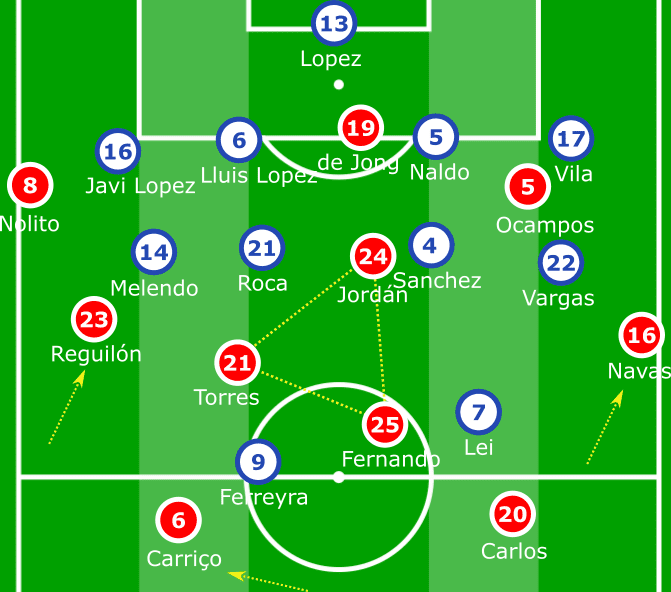
On the left side, Nolito would stay high and wide close to the touchline awaiting a switch of play after an overload on the right side. This also allowed him to cut inside on his stronger right foot to create scoring opportunities. The effect of Nolito staying wide was that Reguilón was given ample freedom to attack the left half-space. This specific tactic created the biggest threat for Sevilla during the entire game.
Sevilla managed 12 shots with four on target. They also attempted 68 long balls completing 38. The long balls were intended as a diagonal switch of play often to Nolito or Ocampos. Although the combination of Navas and Ocampos was a big threat for Espanyol with the first goal as a result of open play that triggered on the right side, it was the left side that became a spearhead of the Sevilla attack with Reguilón at the helm as we will see.
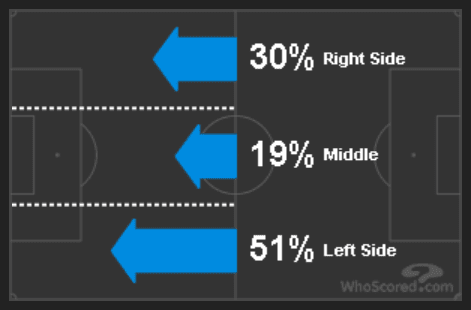
Sevilla’s midfield
In the midfield, we saw plenty of rotation from the trio as we would expect in orthodox Spanish 4-3-3 tactics. The division of roles was clear, yet fluid among the three. Fernando took up the role of the organising midfielder and deepest pivot often slotting in between the central defenders, Diego Carlos and Daniel Carriço. This was important in maintaining control of the team shape from the back as Sevilla looked to keep possession higher up the pitch. Reguilón bursting into midfield aggressively left space for Carriço to cover, while on the other side, Navas moving up meant Carlos had to do the same. This left Fernando at the centre to organise play from behind.
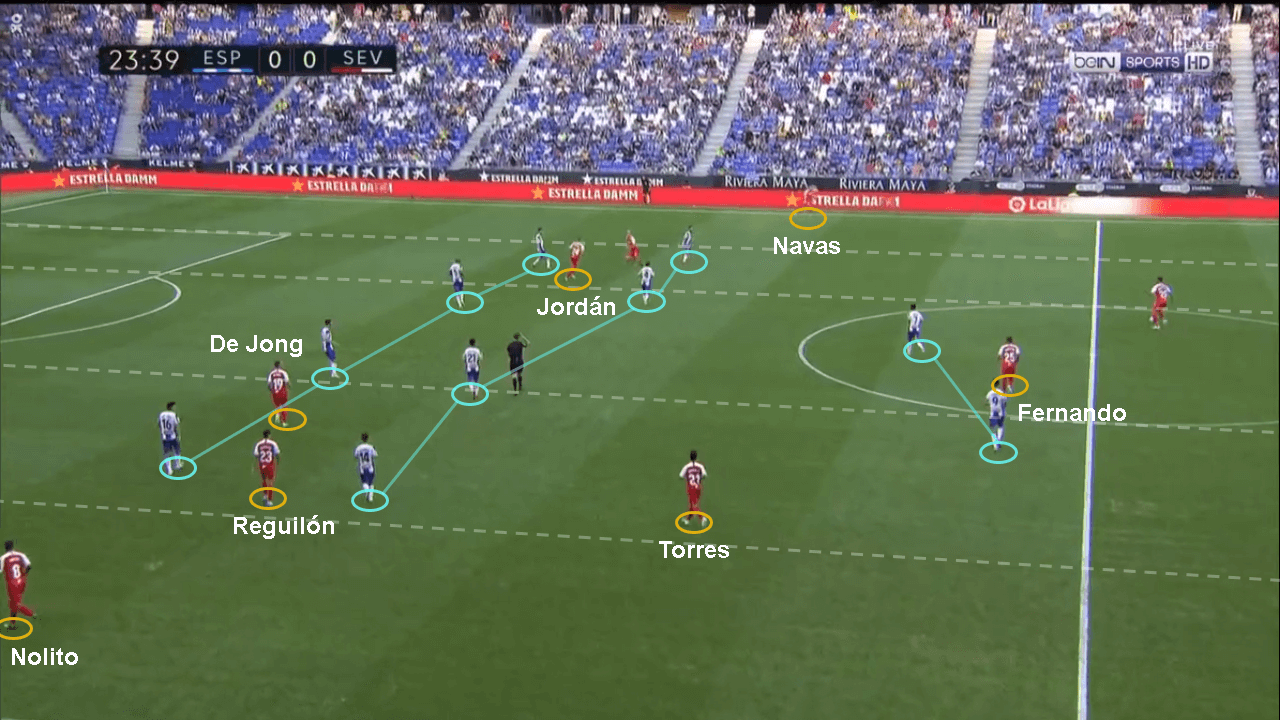
Óliver Torres had a more flexible role in midfield and was focussed more to the left side. Out of possession, Sevilla defended in a 4-2-3-1 shape with Torres and Fernando acting as the double pivot. Torres’ role was also to cover the left back position when Reguilón attacked forward. Although used to playing as a number 10, Torres mostly assisted in keeping the rhythm going in the midfield, playing safe passes. Joan Jordán played higher up than the other two, as an attacking midfielder behind de Jong. Nevertheless, he had a lot of turf to cover with the dynamic rotations in the midfield.
The absence of Éver Banega was evident, especially the threat he possesses at the heart of the Sevilla midfield. His presence could not be filled by any of the three midfielders individually in this game, but their combination enabled Sevilla to play a similar style of attacking football. They dominated possession with 56% throughout the game. When the ball was lost, the strategy was to win it back immediately and quickly organise a counter-attack. A perfect example of this game model was seen in the build-up of the first goal. With effective pressing to close down the space, Sevilla were able to capitalise on the turnover and feed an early cross in from the right side. Although the goal was a mix of luck and a tap-in from Reguilón, it was the desire to push forward that helped create the chance.
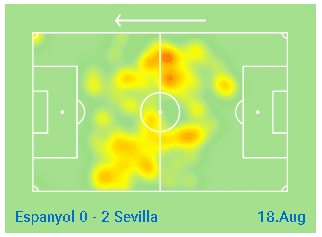
Reguilón’s Impact
If a left-back showed enough potential to leave Marcelo on the bench, then he is no mere hype. Reguilón with his debut goal for Sevilla in the La Liga and his performance lived up to all the expectations. The left-back has tremendous personality. At 22 years, in his first-ever game for the Andalusian side, he commands players around him and oozes confidence in his style of play.
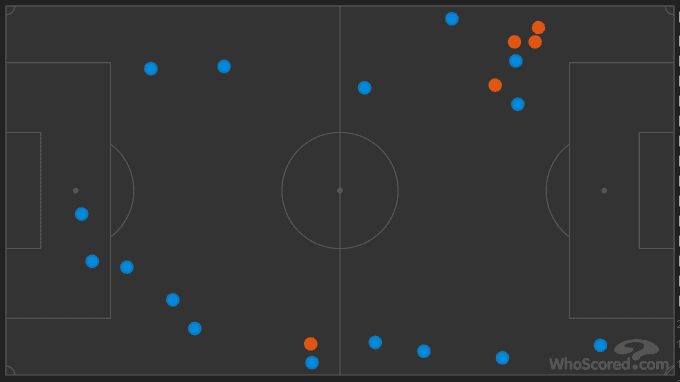
Reguilón dominated the half-space by constantly attacking it even until the 89th minute of the game with the same intensity and work rate. Lopetegui having worked with him at Madrid knew exactly how to unleash his attacking attributes by playing him as an inverted full-back. He was given a lot of freedom to move inside. With Nolito waiting to receive the ball wide, and Torres constantly dropping behind him to cover the space he left, Reguilón would often dart in between the lines of Espanyol’s press to receive the ball and link play with Nolito.

A direct effect of Reguilón’s movement was the right midfielder Óscar Melendo was locked in the half-space to mark Reguilón and couldn’t shift wide during attacking transitions for Espanyol. He managed one shot on target, two off-target and two blocked shots during the game.
Espanyol’s defensive tactics
Espanyol began the game passively, sitting in a low block with an attempt to close down the spaces that Sevilla looked to dissect with their dynamic positional play. The crosses from the right were well defended, and having the captain, Javi López, on the right help take charge of the dual-threat of Nolito and Reguilón.
As the game progressed, Espanyol became sharper in their pressing to close down the spaces higher up and made it uncomfortable for Sevilla to control the possession. The midfield worked tirelessly in guarding the narrow centre of the pitch allowing Sevilla to play wide. This tactic had its advantages and disadvantages. Keeping the shape compact and defending narrow closed the spaces in the centre. Thus de Jong was isolated up top for Sevilla and Ocampos couldn’t create a lot of problems from the right.
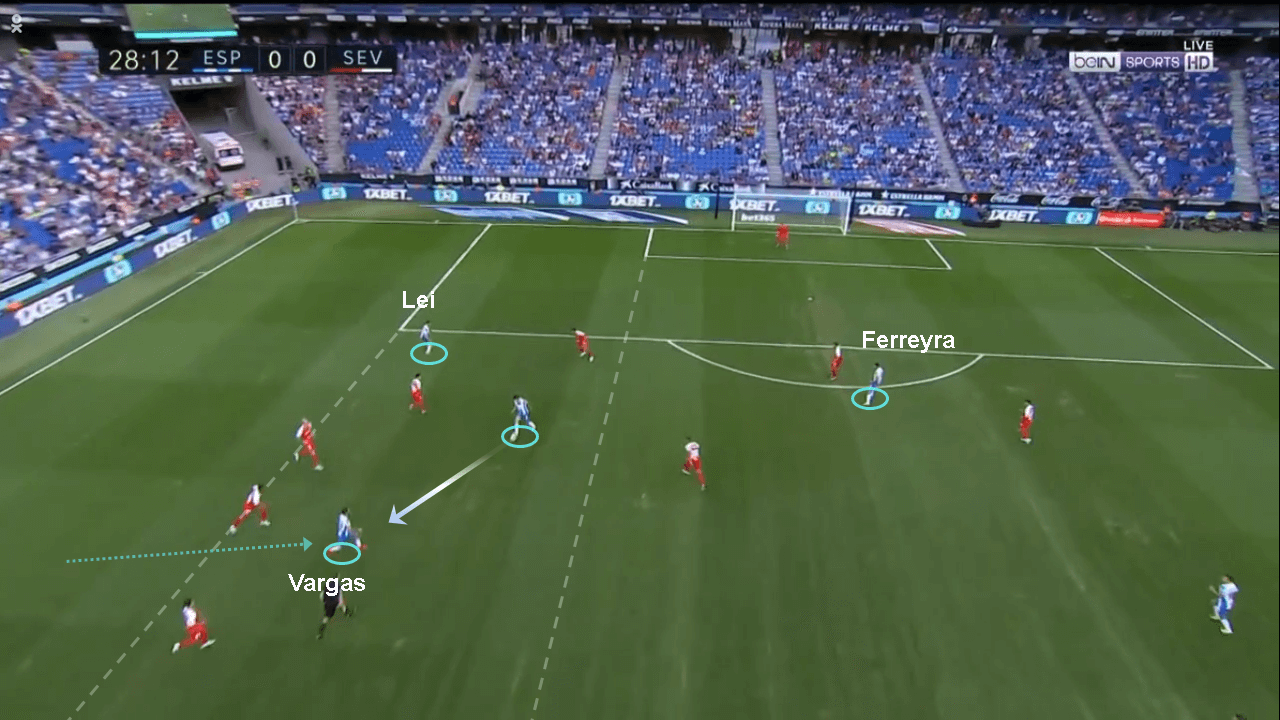
But upon turnover of possession, staying narrow meant they couldn’t exploit the wide spaces in the attacking phase to recycle possession. Espanyol tried too hard to attack from the centre, especially with Vargas, and though they did manage a few shots on target, they couldn’t really test Tomáš Vaclík.

Changes in the second half
Sevilla couldn’t manage a decisive lead to secure the game apart from the single goal minutes before the first half ended. Lopetegui brought on Munir El Haddadi to replace Ocampos to provide a different approach to break down Espanyol’s defence.
Having played passively throughout, Gallego switched to a three-man defence in a 3-2-4-1 formation for the final 10 minutes of the game. This saw Espanyol open up the wide corridors to keep possession and Sevilla found themselves suddenly on the back foot. The second goal for Sevilla came as a result of throw-in that Nolito single-handedly created and was a product of his determination to create chances to score all throughout the game. Although, Espanyol were caught inattentive for the set play that resulted in the goal, the switch of tactics actually made them look stronger against Sevilla.

This begs to question if the change in tactics by Gallego was too late to make an impact in the game. Perhaps the 4-4-2 was too rigid to create attacking opportunities for Espanyol, although defensively, it worked well for the most part of the game.
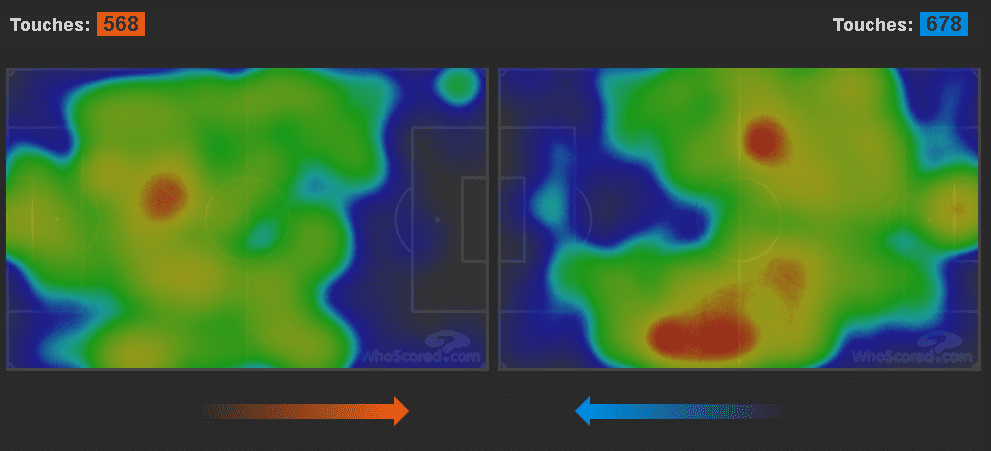
Conclusion
Sevilla’s victory had Reguilón written all over it. With a positive start to their 2019/20 campaign, Sevilla are in second place to Real Madrid in the table, a personal chase for Lopetegui against his former side. Although their attacking tactics proved heavy for an Espanyol side that is still finding the right balance of tactics, we are yet to see how they fare against stronger sides. Do the attacking players like Reguilón and Ocampos have the versatility to show a defensively solid game against sides like Real Madrid and Barcelona?
With the transfer window still open, it’s still early with room for a lot of improvisations in-game models and tweaks in tactics. The departure of Pablo Machín was a statement that Sevilla were focused on results and not just aesthetics in their football. This win against Espanyol is a step in that direction for the southern Spanish side.

If you love tactical analysis, then you’ll love the digital magazines from totalfootballanalysis.com – a guaranteed 100+ pages of pure tactical analysis covering topics from the Premier League, Serie A, La Liga, Bundesliga and many, many more. Buy your copy of the August issue for just ₤4.99 here.

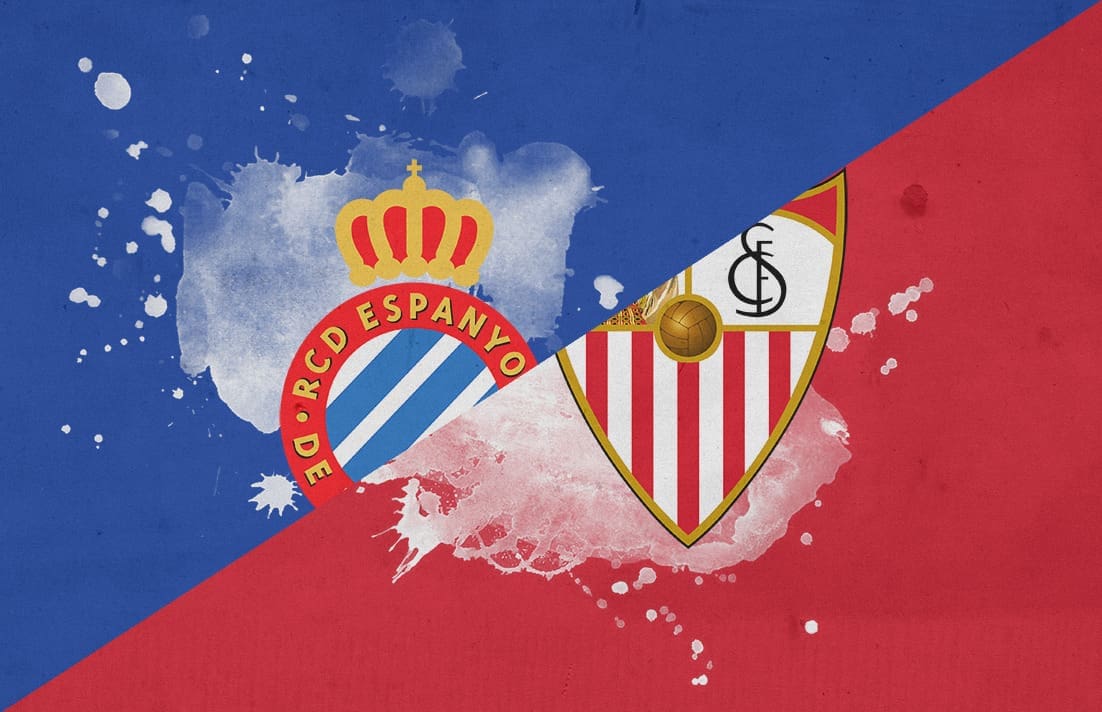


Comments